ASUS UL80Vt First Look: Mobility Redefined
by Jarred Walton on October 24, 2009 8:00 PM EST- Posted in
- Laptops
ASUS UL80Vt Benchmarked - General Performance
This is a first look and we have not yet had a chance to run all of our performance tests. Battery life testing in particular is going to take a long time -- which is a good thing, outside of the testing aspect. We have only had the UL80Vt for two days now, but we have been duly impressed with its features, design, and performance. It may not be the best-looking laptop on the planet, it may not have every feature under the sun, and it certainly isn't the fastest laptop. However, it does everything a typical laptop user could need, it does it at an affordable price point, and it truly manages to redefine what we can expect in terms of mobility from Windows laptops. Here are a few preliminary benchmarks we've run.
We conducted tests using the "moderate battery saving" and "maximum performance" profiles in ASUS' Power4Gear software. Turbo mode (overclocking) was enabled in all testing so far; honestly, we don't see much point in disabling it (which requires a reboot), but we'll test battery life without Turbo mode for the full review; that may add another 5-10% battery life, although the laptop already lasts a full day so it's not a critical concern. The SU7300 CPU has two P-states, 800MHz and 1300MHz; the overclocked FSB results in the SU7300 running at 1066MHz or 1733MHz (using a 4X or 6.5X multiplier). CPU-Z does not report clock speeds correctly (it always showed an 8X multiplier for some reason), but ASUS provided an updated version of Intel's Thermal Analysis Tool that reports the correct speed.
After a few initial tests, we discovered that the only way to get the CPU to run at the 6.5X multiplier is to select "Maximum Performance" in the Power4Gear software, with the maximum CPU speed set to at least 62%; otherwise the CPU will always run at the 4X multiplier. Since we already had a bunch of results for 1066MHz, we decided to report those -- it will make for an interesting comparison with the Intel Atom at least. The 1733MHz results will be in bright green and the 1066MHz results are in dark green in the following charts. We'll start with general performance results using PCMark as well as a few CPU intensive tasks like video encoding and 3D rendering.
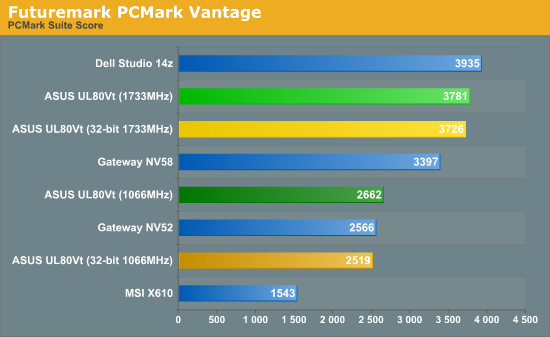
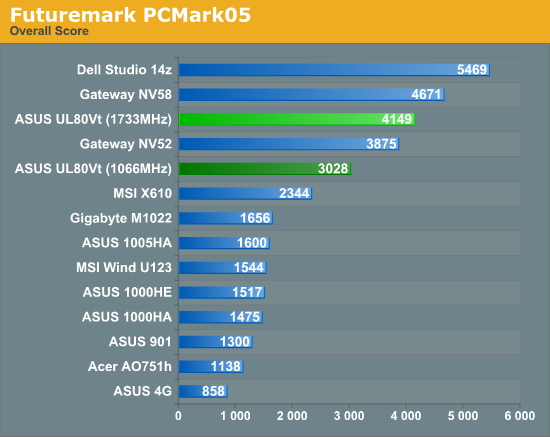
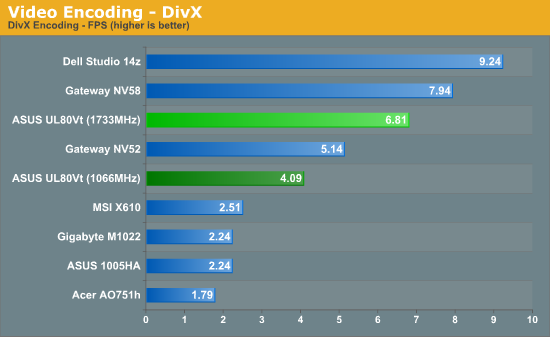
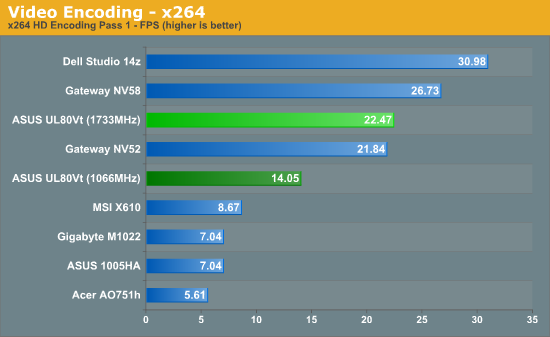
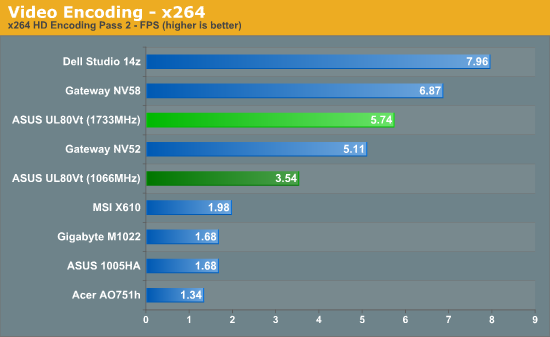
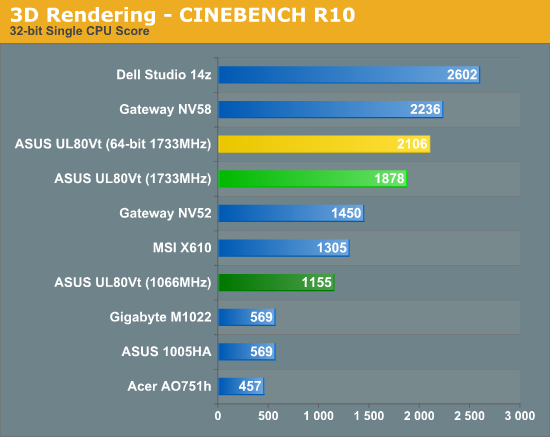
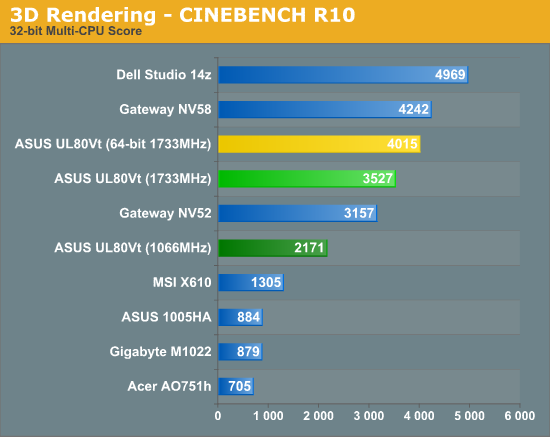
The general performance delivered by the UL80Vt is certainly impressive. It's not the fastest laptop on the market by any means, but application performance is better than the majority of AMD-based laptops currently available. The overclocked SU7300 outperforms the Athlon QL-64 (2.1GHz) by 7% in PCMark05, 47% in PCMark Vantage, 12% in the second x264 encoding pass (the first pass is relatively simple by comparison, depending more on the hard drive and platform than on the CPU), 32% in DivX encoding, and 12% in CINEBENCH R10. The latest 45nm AMD parts like the Turion II Ultra M640 will regain the lead, certainly, but we still have to account for power draw. We'll get to that in a moment, but suffice it to say that it's going to be difficult to beat the overclocked SU7300.
Comparing the UL80Vt to netbooks shows just how slow the Intel Atom is. Even at 1066MHz, the UL80Vt is typically at least twice as fast as the ASUS 1005HA, and at 1733MHz it's 150-250% faster. Sure, it also costs twice as much, but we would make a strong argument that netbooks are only "fast enough" if your demands are low. The bigger selling point for netbooks is their small size and weight, and 14" laptops costing close to $800 certainly encroach on that territory. Netbooks work far better as a second (or third…) PC than as your primary system, while something like the UL80Vt can fill all roles reasonably well. If the general application performance makes netbooks look bad, wait until we look at graphics performance.










100 Comments
View All Comments
ProDigit - Tuesday, October 27, 2009 - link
With the better graphics card I meant the integrated one.. Not the external one.Also, if I'd remove the external graphics card, would I have a PCIE slot available for mods?
ProDigit - Tuesday, October 27, 2009 - link
I don't agree on better LCD's on budget laptops!In fact I oppose it.
I'd rather pay $50 less for a laptop that has a worse LCD, than pay $50 more for a better LCD!
And by the looks of it, we're going that way, with PixelQi's screen which does not display colors faithfully, but could result in upto 20% more batterylife with their white background reflective screens.
I don't care about color precision. A netbook does not need a screen that is showing 32bits faithfully, or that has a high contrast ratio!
What it needs is show basic colors (16 - 24bits is more than ok!), and has a wide range of brightness.
If it isn't reflective (with white background like PixelQi's screens, or e-ink screens), then it needs to have an extreme low setting for comfortably using the PC in a dark room (eg bedroom at night without external light); and the info on the screen should be visible in the daylight, under the sun!
Contrast VS brightness, I'd set my $15 on better brightness settings,rather than pay $50 for a higher quality screen.
Faithful reproduction of screen colors only matter for those who need it, like web designers, photographers, video editors...
But the majority of users are like me. 99% does not care if the green looks a bit blue-ish, or the white looks somewhat a bit yellowish!
strikeback03 - Tuesday, October 27, 2009 - link
But if the screen crushes blacks so badly that all the pics from last Saturdays party that you are looking at on Facebook look like shadows in a coal mine, that screen has failed at even basic functions.Again, I don't think anyone is asking for better screens to be standard, but make them an option in models which are otherwise nice for those who are willing to pay for the upgrade.
atlr - Monday, October 26, 2009 - link
I would pay more for a better display with a matte or antiglare finish.Exile550 - Tuesday, October 27, 2009 - link
I would like very much a matte finish.estyx - Monday, October 26, 2009 - link
Can you please test it when using the GPU for HD-resolution decoding? I.e MPC-HD playing 720p and 1080p h264 with gpu-accel decoding. This is very useful to know when concidering buying a laptop for taking long trips on train, bus, car etc, because then you're so bored you need some movies and series to watch :)Otherwise it seems like a nice laptop! Looking forward for a bit deeper review
JarredWalton - Monday, October 26, 2009 - link
I'm running all sorts of tests as I get the chance. The GMA 4500MHD does x264 offload, as does the G210M. I can tell you that my test x264 720p file just about 6:30 with the 4500MHD; the G210M test is still running. I have a bunch of tests to still run (with and without Turbo, IGP and discrete, gaming performance, etc.) but that will all be revealed eventually. Given the number of tests I still need to run, I expect it to be another week or two before I'm anywhere close to finished.robertpolson - Monday, October 26, 2009 - link
I am dealing with a dilema righ now. Stay with my order for UL80vt, get a macbook pro or wait for UL30vt to come out (if it will) at the end of the year.What I like about UL over macbook pro:
1) Longer battery life
2) More hard drive space
3) Double the memory
What I do not like about UL comparing to macbook pro:
1) No bluetooth
2) Webcam sucks big time - 0.3 megapixel is a joke in 2009
3) Larger in size comapring to macbook pro.
I think I ca live with either OSX and Windows 7.
What do you think ?
JarredWalton - Monday, October 26, 2009 - link
What do you use Bluetooth for? The only time I've ever used it on a laptop was for a Bluetooth mouse, but I'd definitely prefer a wired mouse; the BT mouse was a bit finicky.As for the webcam, I'm not sure if it matters that it's "only" 0.3MP. All the video conferencing stuff I've tried seems to limit me to 320x240 video regardless. I certainly don't take pictures with my laptop webcam; do you?
Mind you, I'm not saying these areas aren't important. You say they are for you, so I'm just wondering what it is you do that I may have overlooked, since I've never felt either was necessary.
PS - Benefit #4: optical drive, if you need it.
heulenwolf - Monday, October 26, 2009 - link
Dear Asus,I've been tracking netbooks since you released the first EEEPC. I always found them interesting but, despite their low price, continued to buy larger laptops or smaller internet-enabled devices until the 1005HAB came out. I saw it while perusing a Best Buy and could not resist. The screen is so nice to look at that it makes me look past some of the drawbacks inherent in a netbook. When at home, I'll gladly use the $300 netbook instead of my $2000 work laptop with a larger screen, faster and better everything (except for the screen, though its no slouch), and longer battery life. When I'm traveling, I don't even consider other options. I bring the 1005HAB. If you'd like this happy Asus EEEPC customer to purchase more lucrative Asus products in the future, please give more weight to the screen quality in your value proposition than was demonstrated in this review.